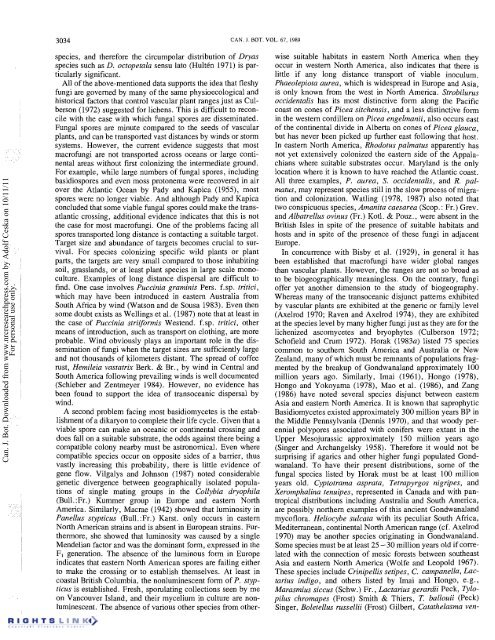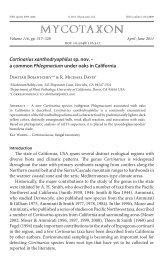Redhead Fungal Biogeography.pdf - Mushroom Hobby
Redhead Fungal Biogeography.pdf - Mushroom Hobby
Redhead Fungal Biogeography.pdf - Mushroom Hobby
You also want an ePaper? Increase the reach of your titles
YUMPU automatically turns print PDFs into web optimized ePapers that Google loves.
Can. J. Bot. Downloaded from www.nrcresearchpress.com by Adolf Ceska on 10/11/11<br />
For personal use only.<br />
3034<br />
species, and therefore the circumpolar distribution of Dryas<br />
species such as D. octopetala sensu lato (Hult6n 1971) is par-<br />
ticularly significant.<br />
All of the above-mentioned data supports the idea that fleshy<br />
fungi are governed by many of the same physioecological and<br />
historical factors that control vascular plant ranges just as Cul-<br />
berson (1972) suggested for lichens. This is difficult to recon-<br />
cile with the ease with which fungal spores are disseminated.<br />
<strong>Fungal</strong> spores are minute compared to the seeds of vascular<br />
plants, and can be transported vast distances by winds or storm<br />
systems. However, the current evidence suggests that most<br />
macrofungi are not transported across oceans or large conti-<br />
nental areas without first colonizing the intermediate ground.<br />
For example, while large numbers of fungal spores, including<br />
basidiospores and even moss protonema were recovered in air<br />
over the Atlantic Ocean by Pady and Kapica (1955), most<br />
spores were no longer viable. And although Pady and Kapica<br />
concluded that some viable fungal spores could make the trans-<br />
atlantic crossing, additional evidence indicates that this is not<br />
the case for most macrofungi. One of the problems facing all<br />
spores transported long distance is contacting a suitable target.<br />
Target size and abundance of targets becomes crucial to sur-<br />
vival. For species colonizing specific wild plants or plant<br />
parts, the targets are very small compared to those inhabiting<br />
soil, grasslands, or at least plant species in large scale mono-<br />
culture. Examples of long distance dispersal are difficult to<br />
find.. One case involves Puccinia graminis Pers. f. sp. tritici,<br />
which may have been introduced in eastern Australia from<br />
South Africa by wind (Watson and de Sousa 1983). Even then<br />
some doubt exists as Wellings et al. (1987) note that at least in<br />
the case of Puccinia striiformis Westend. f.sp. tritici, other<br />
means of introduction, such as transport on clothing, are more<br />
probable. Wind obviously plays an important role in the dis-<br />
semination of fungi when the target sizes are sufficiently large<br />
and not thousands of kilometers distant. The spread of coffee<br />
rust, Hemileia vastatrix Berk. & Br., by wind in Central and<br />
South America following prevailing winds is well documented<br />
(Schieber and Zentmeyer 1984). However, no evidence has<br />
been found to support the idea of transoceanic dispersal by<br />
wind.<br />
A second problem facing most basidiomycetes is the estab-<br />
lishment of a dikaryon to complete their life cycle. Given that a<br />
viable spore can make an oceanic or continental crossing and<br />
does fall on a suitable substrate, the odds against there being a<br />
compatible colony nearby must be astronomical. Even where<br />
compatible species occur on opposite sides of a barrier, thus<br />
vastly increasing this probability, there is little evidence of<br />
gene flow. Vilgalys and Johnson (1987) noted considerable<br />
genetic divergence between geographically isolated popula-<br />
tions of single mating groups in the Collybia dryophila<br />
(Bull.:Fr.) Kummer group in Europe and eastern North<br />
America. Similarly, Macrae (1942) showed that luminosity in<br />
Panellus stypticus (Bull.:Fr.) Karst. only occurs in eastern<br />
North American strains and is absent in European strains. Fur-<br />
thermore, she showed that luminosity was caused by a single<br />
Mendelian factor and was the dominant form, expressed in the<br />
F, generation. The absence of the luminous form in Europe<br />
indicates that eastern North American spores are failing either<br />
to make the crossing or to establish themselves. At least in<br />
coastal British Columbia, the nonluminescent form of P. styp-<br />
ticus is established. Fresh, sporulating collections seen by me<br />
on Vancouver Island, and their mycelium in culture are non-<br />
luminescent. The absence of various other species from other-<br />
CAN. I. BOT. VOL. 67, 1989<br />
wise suitable habitats in eastern North America when they<br />
occur in western North America, also indicates that there is<br />
little if any long distance transport of viable inoculum.<br />
Phaeolepiota aurea, which is widespread in Europe and Asia,<br />
is only known from the west in North America. Strobilurus<br />
occidentalis has its most distinctive form along the Pacific<br />
coast on cones of Picea sitchensis, and a less distinctive form<br />
in the western cordillera on Picea engelmanii, also occurs east<br />
of the continental divide in Alberta on cones of Picea glauca,<br />
but has never been picked up further east following that host.<br />
In eastern North America, Rhodotus palmatus apparently has<br />
not yet extensively colonized the eastern side of the Appalachians<br />
where suitable substrates occur. Maryland is the-only<br />
location where it is known to have reached the Atlantic coast.<br />
All three examples, P. aurea, S. occidentalis, and R. palmatus,<br />
may represent species still in the slow process of mkration<br />
and colonization. Watling (1978, 1987) also noted that<br />
two conspicuous species, Amanita caesarea (Scop. : Fr.) Grev.<br />
and Albatrellus ovinus (Fr.) Kotl. & Pouz., were absent in the<br />
British Isles in spite of the presence of suitable habitats and<br />
hosts and in spite of the presence of these fungi in adjacent<br />
Europe.<br />
In concurrence with Bisby et al. (1929), in general it has<br />
been established that macrofungi have wider global ranges<br />
than vascular plants. However, the ranges are not so broad as<br />
to be biogeographically meaningless. On the contrary, fungi<br />
offer yet another dimension to the study of biogeography.<br />
Whereas many of the transoceanic disjunct patterns exhibited<br />
by vascular plants are exhibited at the generic or family level<br />
(Axelrod 1970; Raven and Axelrod 1974), they are exhibited<br />
at the species level by many higher fungi just as they are for the<br />
lichenized ascomycetes and bryophytes (Culberson 1972;<br />
Schofield and Crum 1972). Horak (1983~) listed 75 species<br />
common to southern South America and Australia or New<br />
Zealand, many of which must be remnants of populations fragmented<br />
by the breakup of Gondwanaland approximately 100<br />
million years ago. Similarly, Imai (1961), Hongo (1978),<br />
Hongo and Yokoyama (1978), Mao et al. (1986), and Zang<br />
(1986) have noted several species disjunct between eastern<br />
Asia and eastern North ~merica. It is known that saprophytic<br />
~asidiomycet'es existed approximately 300 million years BP in<br />
the Middle Pennsylvania (Dennis 1970), and that woody perennial<br />
polypores associated with conifers were extant in the<br />
Upper Mesojurassic approximately 150 million years ago<br />
(Singer and Archangelsky . 1958). Therefore it would not be<br />
~<br />
surp&sing if agarics and other higher fungi populated Gondwanaland.<br />
To have their present distributions, some of the<br />
fungal species listed by Horak must be at least 100 million<br />
years old. Cyptotrama asprata, Tetrapyrgos nigripes, and<br />
Xeromphalina tenuipes, represented in Canada and with pantropical<br />
distributions including Australia and South America,<br />
are possibly northern examples of this ancient Gondwanaland<br />
mycoflora. Heliocybe sulcata with its peculiar South Africa,<br />
Mediterranean, continental North American range (cf. Axelrod<br />
1970) may be another species originating in Gondwanaland.<br />
Some species must be at least 25 -30 million years old if correlated<br />
with the connection of mesic forests between southeast<br />
Asia and eastern North America (Wolfe and Leopold 1967).<br />
These species include Crinipellis setipes, C. campanella, Lactarius<br />
indigo, and others listed by Imai and Hongo, e.g.,<br />
Marasmius siccus (Schw.) Fr., Lactarius gerardii Peck, T.10pilus<br />
chromapes (Frost) Smith & Thiers, T. ballouii (Peck)<br />
Singer, Boletellus russellii (Frost) Gilbert, Catathelas~na ven-



